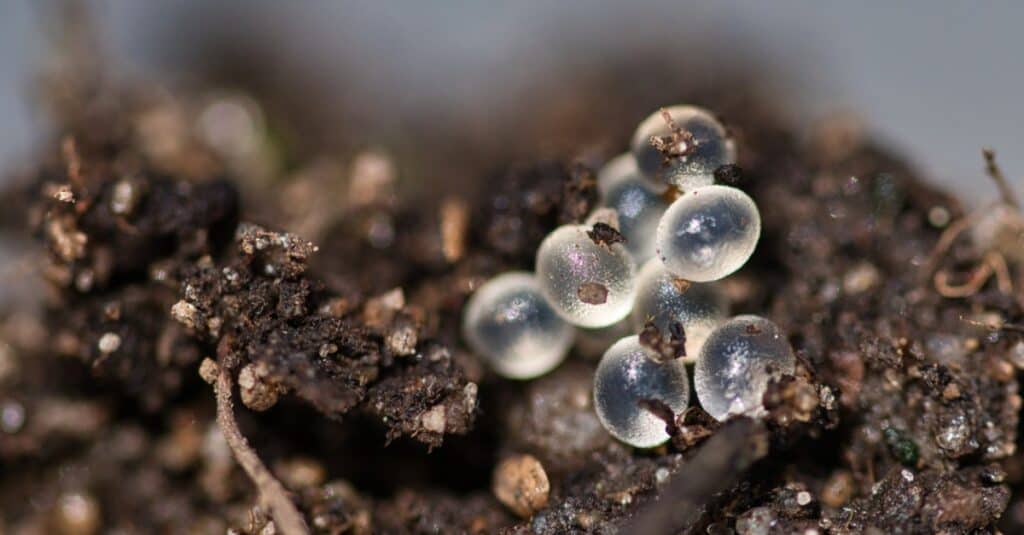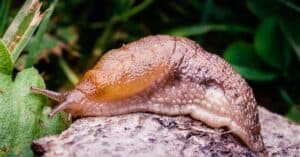Slugs are often regarded as pretty basic creatures, but slug reproduction is far from simple. Slugs can reproduce through both sexual and asexual reproduction. They are hermaphrodites possessing both male and female reproductive organs. Slugs usually find a mate and exchange sperm so that it can fertilize the egg. However, some slug species can self-fertilize or the egg cell can develop into an embryo without a sperm. Batches of eggs are laid in damp, dark places where they develop and hatch into baby slugs.
Let’s take a closer look at how these fascinating creatures produce new slugs.
How Do Slugs Sexually Reproduce?
Most slug species use sexual reproduction which means that male gametes (sperm cells) and female gametes (eggs) need to fuse to produce new slugs. Therefore, slugs need to find and attract an individual of the same species and carry out the transfer of sperm to the egg. This is called mating.
Because slugs are hermaphrodites, they can mate with any other slug of the same species. It doubles their chances of finding a suitable partner because there are no males or females. Nevertheless, slugs conduct complex mating rituals that fulfill an important role in the selection of an appropriate mate.
What Are the Mating Rituals of Slugs?
Mating rituals are the start of the sexual reproduction process. They may seem a little bizarre to us, but they have evolved over millions of years for some important purposes. Firstly, they ensure that the slugs are mating with another of their species. Secondly, they require a lot of exertion and mucus production which ensures that only animals in good physical condition mate with each other. Different slug species have specific mating rituals.
As the clip below shows, one standout example is the ash black slug (Limax cinereoniger) which is one of the largest land slugs in the world and a resident of ancient woodlands in the UK. When looking for a partner, the slugs move to the treetops and start to leave a trail of slime laced with pheromones. These powerful chemical signals are irresistible to other ash-black slugs. The pair of slugs first nuzzle each other to ensure that they are suitably matched. Then, suspended from an overhanging branch their penises intertwine, becoming as long as their bodies. Each passes a packet of sperm to the other slug. When the transfer is complete, both slugs drop to the forest floor.
What Is the White Substance Between Mating Slugs?
If you spot two slugs close together in your garden, the white substance that you can see is slime or mucus. It plays a crucial role in attracting a mate. Also, in many species of slug, a lot of slime is produced during mating itself.
What Is the Blue Thing That You See Between Mating Slugs?
Leopard slugs are commonly found throughout the US and many other countries. This species starts reproduction by finding an overhanging branch on which to mate. The two slugs entwine which takes about an hour. Then, they let go of the branch and lower themselves down on a rope of mucus. In mid-air, they turn their male sex organs outwards (this is from behind their heads) and these elongate, intertwine, and then fan out. So, as you see in the clip below, the blue thing that you see between mating slugs that looks like a translucent petalled blue globe is intertwined penises.
Spermatophores (compact capsules of sperm) pass from one slug to another and both slugs are fertilized. Finally, they let go and drop to the ground. However, sometimes the slugs struggle to disentangle. When this happens, one will bite off their partner’s penis and drop to the ground whilst eating it. This is a behavior called apophallation and also provides a large meal of protein that helps the aggressor to nourish their eggs. It is also seen in other slug species including the banana slug.
Where Do Slugs Lay Eggs?

Slug eggs are deposited in damp, dark places.
©iStock.com/Ewa Saks
Fertilized eggs are deposited in the environment after mating. Most slugs deposit their eggs in clusters, and they select a sheltered, damp, and dark place to do this. You’re most likely to find slug eggs in soil crevices, under rocks, or around decaying plant material. Different slug species have different preferences for where and when they lay their eggs.
For example, the gray field slug, also called the grey garden slug, (Deroceras reticulatum) deposits clusters of around 40 eggs in sheltered cavities near the soil surface. These are small, pearl-like translucent eggs when they are freshly laid but as they mature, they turn white. Leopard slugs deposit their eggs in clusters of over 100 eggs that are slightly attached. They are transparent but slightly yellowish and can be covered in mucus. Some adult slugs die once they have deposited their eggs.
Where Do Sea Slugs Lay Eggs?
Some sea slug species deposit their eggs in the water and these hatch into shelled planktonic larvae. Ocean currents disperse them over wide areas. Other species lay a small number of larger yolked eggs. These hatch directly into tiny sea slugs.
Do Slugs Have a Mating Season?
In temperate climates, slugs tend to mate in the spring (around March to June) and in the fall (between October and November). This is when you are most likely to spot slug eggs in your garden.
How Long Do the Eggs Take to Hatch?
This varies with both the species and the environmental conditions – faster hatching occurs in ideal conditions which are damp and warm. It can be anything from days to several weeks. The eggs of the spotted garden slug hatch in about 30 days at 24 degrees C but faster at higher temperatures. The grey garden slug’s eggs hatch after 100 days at 32 degrees to 40 degrees but after 10 days if it is warmer. Moisture is extremely important for the survival of slug eggs. If it is too hot, the eggs can dry out and will not hatch at all.
If slugs deposit their eggs in the winter, it can take five months for them to hatch – the eggs will over-winter in the ground and hatch in spring.
What Happens to Newly Hatched Slugs?
The newly hatched slugs are called neonates and look just like tiny versions of their parents. They often have the same coloration as adults, but some are paler. They start eating straight away – rasping leaves for algae and fungus. Neonates do not tend to travel very far when they are immature. Instead, they hang around in a colony near where the eggs were deposited. Eventually, they become juveniles and then adult slugs who move further away. Once they reach maturity, they will start looking for a mate and the cycle will start all over again.

Once slugs reach maturity they start looking for a mate.
©Dieter Hawlan/iStock via Getty Images
What Is Asexual Slug Reproduction?
Some slugs reproduce via asexual reproduction. This allows the slug to reproduce themselves without having to find a mate. Apomictic parthenogenesis is one method by which this can be achieved. It essentially means that an embryo develops from an unfertilized egg and the offspring are clones of the mother.
Asexual reproduction is quicker and is a good option if there are no partners around to mate with. It is also useful if the environmental conditions are not ideal for sexual reproduction. Being able to fall back on asexual reproduction increases the chances of survival for a slug species.
Summing up Slug Reproduction
Slugs are hermaphrodites and can reproduce asexually by themselves or sexually by finding a mate. They signal to other slugs that they are ready to mate by releasing pheromones in their slime. The act of mating can be elaborate and is followed by the depositing of eggs in sheltered damp places. The eggs hatch quicker in warm conditions releasing neonate slugs that look like miniature versions of their parents.
The photo featured at the top of this post is © Marek Mierzejewski/Shutterstock.com
Thank you for reading! Have some feedback for us? Contact the AZ Animals editorial team.





